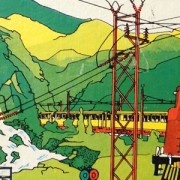Power’s Price Tag
Mike Knotts, director of government affairs
When you go to the store to buy something, you usually take a look at the price tag before you decide to purchase it, don’t you? Few of us can just buy what we want no matter the cost, so we have to consider price along with the other factors to help us decide whether to buy a product.
Usually that price is clearly displayed for us to see. At the gas pump, the price towers in foot-tall numbers out by the street to make sure we don’t miss it. At the grocery store, there are price labels all over the place — not to mention all the “buy-one, get-one-free” and “10-for-a-dollar” promotions that are intended to make us think about the value of a particular product at a particular price. And with most things we buy, we provide some sort of compensation before we actually receive the product.
So it is very interesting to me that there is a product most of us buy of which we likely don’t know the price, don’t know how much we are buying and don’t pay for it until 30 to 45 days after we use it. It’s a product you are probably using as you read this page. And it’s a product that, in today’s society, we can’t really live without.
Electricity is probably one of the least understood consumer products on the planet. For most of us, we just know to plug our appliances into the outlet in the wall and they will work. Then, once a month, we get a bill and have to pay whatever the total says we owe. Sometimes we are relieved that the bill is low, and other times we groan when the numbers are high.
There are lots of reasons why electricity is billed this way, but there is one distinction that differentiates the most common energy source in the world from other fuels you may buy. You see, electricity has to be produced (generated is the more technical term) at the exact instant you consume it. This one fact is the primary reason why the electric power industry is so complex and why our ability to provide reliable power is such an achievement.
When you flip the switch to turn on the lights, the electrons that power that fixture have literally travelled hundreds of miles across a huge network of wires and transformers. Those electrons move at the speed of light — that’s 671 million miles per hour. Any interruption like a tree limb touching a power line or a faulty piece of equipment can stop that long trip and cause a power outage.
“That’s not so different,” you might say. Lots of the products we consume today come from a long way away. Take the gasoline you pump into your car or truck, for instance. It has also travelled many miles and has required many hours of refining to arrive at your local gas station. But that gasoline made many stops along its trip to be stored in huge tanks, sometimes for days or weeks at a time.
Unlike any other fuel — propane, natural gas, etc. — there is no way to store large amounts of electricity for long periods. There is no “tank” where we can deposit electricity and hold it until it’s needed. So that means that power plants must continuously generate more power than is required, just in case the entire city decides to turn on their air conditioners at the same time.
This can create tremendous challenges for your cooperative and its power supplier, the Tennessee Valley Authority. While an electricity “tank” may not be a reality yet, there are lots of new technologies that allow us to better manage the flow of electricity and understand how to do a better job of delivering it to you at the lowest possible cost. These types of improvements, often referred to as the “smart grid,” are changing the way our industry performs its crucial task. I made the analogy to a friend recently that the electricity industry has known for many years how to win a NASCAR race driving a 1950s Studabaker, but it is now time to get a new ride.
And it is these types of technologies that very well may change the way we consume our electricity. Instead of not knowing how much we are using and what the price is, we will soon be able to make better-informed decisions about how we use electricity and what it will cost us. And that is an improvement that benefits us all.








